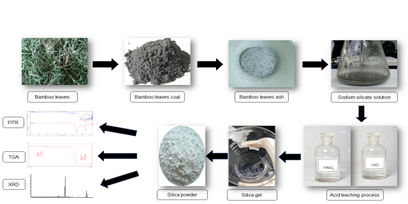Extraction of Silica from Bamboo Leaves Ash (Bambusoideae) Using Hydrochloric Acid and Nitric Acid

- Extraction,
- Silica,
- Rice husk
Copyright (c) 2023 Orbital: The Electronic Journal of Chemistry

This work is licensed under a Creative Commons Attribution-NonCommercial-NoDerivatives 4.0 International License.
Abstract
Bamboo leaves, a readily available agricultural waste globally, serve as a valuable source of organic silica, often referred to as biosilica. Despite containing a substantial silicon dioxide (SiO2) content, bamboo leaves are frequently discarded by communities. Remarkably, the silica content in bamboo leaves exceeds 70%. Acid leaching is employed to extract the silica, with various factors and types of acids being compared in the process. The resulting silica is highly porous and firmly bonded. The extracted silica's purity, amorphous nature, and the presence of functional groups have been verified through XRD and FTIR studies. Additionally, TGA is utilized to monitor the material's weight changes with increasing temperature.




